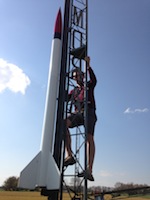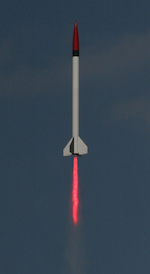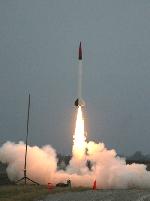IQSY Tomahawk

| Diameter: | 6.01" | Type: | Scale |
| Length: | 123" | Status: | Active - 4 flights |
| Motor Mount: | 98mm | Build Dates: | 2011-10-01 to 2012-06-30 |
When I was little, one of my prospective L3 projects when I grew up was a 2/3 scale IQSY Tomahawk. I even got as far as to spec it out for pricing via Smokin' Rockets. Though I kept the design around, I never built it. But at LDRS 30, Wildman's made me an offer on a Competitor 6 I couldn't refuse, and I promptly set about turning it into a Tomahawk instead. The fins are 3/16" G10, expertly beveled by Justin Farrand, with a layer of 8.9 oz carbon and a layer of 6 oz glass to the motor tube. The old Competitor fin slots were filled and four new ones were cut to accept the new profile. I also added 12" to the booster to make room for a 17.5k case (using tubing from the payload). Other than that, it's a pretty standard 6" all fiberglass rocket which is very stable and durable. And I finally got to fulfill my childhood dream!
Flights
I bought out the remainder of Aerotech's KBA stock when they shut the line down, and was excited to fly my first one. While I was repairing the IQSY from its cattle fence incident, I also took the opportunity to upgrade the parachute to an R16 for slower descents, especially in the thin desert air. Since I hadn't built a 7600 in a couple of years, I of course made the n00b mistake of gluing the grains without sticking the liner in the motor case with the bulkhead/nozzle in place. After spending 2+ hours with a chisel, things finally fit together. Luckily, the wind remained calm all day long, and I made it out to the pads just before sunset. Robert DeHate gave me some thermite to use for ignition, and David Smith was on the mic. The Tomahawk lit right up and made a gorgeous flight into the still desert air. Apogee was clearly visible, and we tracked it all the way down. Though it was descending what seemed like a half mile out, the unfurling main parachute was clearly audible in the desert stillness. The rocket landed gently and Andrew and I went out to fetch it. A perfect flight on a scale model at the NAR's national sport launch!

others: on the pad | no fences here
video
The overcast morning did not bode well for my flight, but at about 2 in the afternoon things started to clear, so I pulled the two pieces out of the car and started putting it together. Foxy loaned me some electrical tape and an igniter, and Devin helped me shove in the shear pins. Before I could load it, I had to bug Gus (who had just showed up) to set up his pad. With that taken care of, my roommates Jonathan and Eric helped me schlep the 50 lb bird through RSO and to the pad. Eric Merrill helped me put it on the rail, and after raising it up and angling it into the wind a little bit, I armed the avionics and installed the igniter. The new MARSA54 powered up and behaved well-I, of course, had to fly it because John Dermiggio was on site-and then it was back to the flight line for the launch. Richard Cash was on the button and I snapped photos as the rocket cleared the rail on a long string of orange shock waves; much to my chagrin, the liftoff photo is backfocused, womp womp. The rocket boosted nicely, weathercocking into the breeze, and disappeared at burnout. I had a good signal on the tracker, but soon Tom McFee spotted it on the way down, just as the mains opened at 1000 feet. The rocket landed next to the road again, making recovery easy. However, I noticed a big black splotch on the payload section, and working my way down the shock cord to the booster, I noticed a big crack in the fillet along the base of the black fin. My guess is that the Skyangle drogue just couldn't compete with the big fins in the windy conditions, allowing the payload section to smack the booster on the way down; time to step up to something bigger. The main chute also had an encounter with the barbed wire fence next to the road. Other than that, though, everything came back in one piece. A little epoxy and ripstop and we'll be back to live action.

others: preflight on the guspad | blurry roarrrr
I wanted to make something nice for Red Glare since last time I only showed up with one measly 2550 to fly, and a big batch of 5/3 carb red was just the ticket. I elected to re-fly the Tomahawk on the 7600 case since I knew it would perform well and give a nice flame. Loading was easy on one of MDRA's famous hydraulic towers, and after fiddling with the avionics for a bit (ran the wires out the hole closest to the rail -- oops), I turned in the card and Neil counted down. The motor lit up nicely and carried the rocket into the sky on a shockwave-laden red laser beam. The Raven fired the drogue a little early on the way up (still going ~125 ft/sec per the ARTS and it shows up in the Raven baro graph too), but it all held together for a nice main deployment, thunking down in the soft grass field under the R14 and sticking the landing. Special thanks to Todd and Dan for helping me carry it out of the field!

others: pad prep | stuck the landing
video
As always with a first flight, prep was slow as the build process was finished completely (install nose cone eyebolt, drill shear pin holes, double check motor retention). But everything went smoothly and I showed up to the launch site at about 4:00 with the rocket ready to go -- turn on the tracker, make an igniter, and put in the booster shear pins and it was time for the pad. Brian Perry and Tom McFee helped put it on the tower and raise it into the starting position, and we were all set by 4:30. Ignition was smooth, aided by the clean grain faces (o-rings + tape on the glue job) and beefy blue propellant-augmented igniter, and the rocket clawed up the tower at 8 gees on a nice 10 foot white flame. The boost was arrow straight with about 1 complete roll during the motor's burn -- not bad for fins aligned by eye, and I think Justin's pro beveling job helped a lot too -- and with a puff of slag, the motor shut down smoothly. We all heard the apogee event and reacquired visual a few seconds later; main was on time at 1000' thanks to the Raven (the ARTS didn't fire its backup charge - humm). Touchdown was nominal just a few feet from the next road to the north. Descent rate was a little high on the R14C main so I'll probably switch to an R16 next time around, but other than that, I couldn't ask for a better first flight. Thanks to Brian, Tom, and Creighton for all the help!


